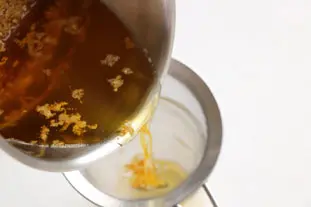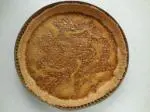Noisette butter
"Noisette" means hazelnut in French. Noisette butter is made by melting butter, then boiling and raising it to a high temperature until it takes on both a light brown hazelnut colour and also a characteristic nutty smell.
Compared with simple clarified butter, this noisette butter has a delicate yet distinctive flavour which is a welcome addition to both savoury and sweet recipes (particularly in cakes and pastries).
Compared with simple clarified butter, this noisette butter has a delicate yet distinctive flavour which is a welcome addition to both savoury and sweet recipes (particularly in cakes and pastries).
144 K 4.0/5 (23 reviews)
Last modified on: August 27th 2025
For 100 g, you will need:
- 1
 125 g butter
125 g butter - Total weight: 125 grams
Times for this recipe
Cooking: 15 min.
Step by step recipe
Cut 125 g butter into pieces, put into a saucepan on medium heat and melt.
Note: Cutting the butter into pieces for this stage, rather than starting with a large block, allows it to melt and raise its temperature more evenly.
Note: Cutting the butter into pieces for this stage, rather than starting with a large block, allows it to melt and raise its temperature more evenly.
At the end of the cooking process, the butter will have stopped bubbling, or almost, and will now be a light brown colour and give off a hazelnut smell.
Take the pan off the heat and stand it immediately in cold water for 30 seconds to stop the cooking.
Note: It is very important to cool the butter like this, or it will continue to heat up, even off the hob, and will end up burning and turning black.
Note: It is very important to cool the butter like this, or it will continue to heat up, even off the hob, and will end up burning and turning black.
The hazelnut butter thus obtained, and this is normal, contains small impurities, the buttermilk, which has cooked with it and is best removed.
Filter the noisette butter through a fine strainer.
Remarks
You can avoid cooling the pan in stage 7 by filtering the noisette butter immediately into another (cold) container.
You can also use slightly salted butter, but do be aware that the cooking to noisette stage will concentrate the initial saltiness.
You will have noticed how hot the butter gets towards the end of cooking — a bit like making caramel — so I advise you not to make it when there are young children in the kitchen.
You can also use slightly salted butter, but do be aware that the cooking to noisette stage will concentrate the initial saltiness.
You will have noticed how hot the butter gets towards the end of cooking — a bit like making caramel — so I advise you not to make it when there are young children in the kitchen.
Keeping: Several days in the fridge, in a sealed container.
Source: Home made.
How much will it cost?
- For 100 g : 0.90 €
Change currency:
Note: Be careful, these prices are only an estimate, you can consult the table of prices by ingredients used for this estimate.
Some other recipes using this recipeSee them all 10
Pistachio "Financiers"
This version of the traditional French financiers is just as moist as the original but with a delicious pistachio flavour.
91 K3.9 35 min.
Génoise (Genoa sponge)
A Génoise (or Genoa sponge) is a very light and delicate cake. It is good on its own, but is more often used as the base for many different French-style gâteaux, with layers of mousse or cream between 2 (or more) layers of sponge. It is a tricky recipe to get right, rather technical, but here's a...
247 K 53 1 hour 15 min.
Grapefruit moelleux
The french love their "moelleux" — moist fondant cakes, often with a melting centre. These little mini-moelleux are flavoured with grapefruit. The grapefruit flavour is brought out fully by using a combination of juice, zest and candied peel.
66 K5 1 hour 7 min.
Lemon and lime cakes
These little cakes get their double citrus flavour by combining the delicate bitterness of lemon and lime zest with the slight sharpness of the juice in a syrup, soaked into the cakes while still hot from the oven.
59 K 1 hour 45 min.
Pancake batter
Here is a pancake batter that is a little more sophisticated than the traditional version. The pancakes will be tastier with a softer texture.
388 K3.8 15 min.
This recipe uses (among others)

Butter
Like these other recipes: Brioche Tatin, Potatoes with prawns, Quick Strawberry Millefeuille, Spinach Croque-monsieur , Crème de foie gras, ... See them all 485
Other recipes you may also like
French dressing (vinaigrette)
Here is a very simple recipe, but it could completely transform, maybe even transcend, your salad. July 7th 20111.07 M4.5 7 min.
Stewed apple (compote)
Here is a very basic but delicious recipe, and the pitfalls to avoid. November 8th 20172.46 M 14.8 1 hour 15 min.
Simple maple-syrup tart
It would be hard to find a simpler tart recipe: just sweetcrust pastry filled with maple syrup, then baked. November 5th 201468 K4.2 50 min.
Fruit crémeux
This kind of "crémeux" (it means "creamy", but contains no actual cream) is a basic recipe in the repertoire of French pastry chefs. It is smoother but less frothy than a mousse and uses gelatin to set it as it cools. Often used as a tart filling or in other desserts, crémeux is usually poured to set in a mould. This fruity version is made with raspberries. September 12th 2020202 K2.5 40 min.
Duo of slow-cooked pork
Two pork ingredients, smoked sausage and a shoulder joint here, are left to cook slowly on a bed of vegetables and herbs, moistened with a vegetable or poultry stock. This is one of those crafty dishes that can be reheated over and over, getting better each time. November 18th 201888 K 4 hours 50 min.
News list of cooking-ez.com
Sign up to receive the latest recipes (next batch due to be sent on 2026-01-11)
Note: We'll never share your e-mail address with anyone else.
Post a comment or question
Follow this recipe
If you are interested in this recipe, you can "follow" it, by entering your email address here. You will then receive a notification immediately each time the recipe is modified or a new comment is added. Please note that you will need to confirm this following.
Note: We'll never share your e-mail address with anyone else.
Alternatively: you can subscribe to the mailing list of cooling-ez.com , you will receive a e-mail for each new recipe published on the site.




















